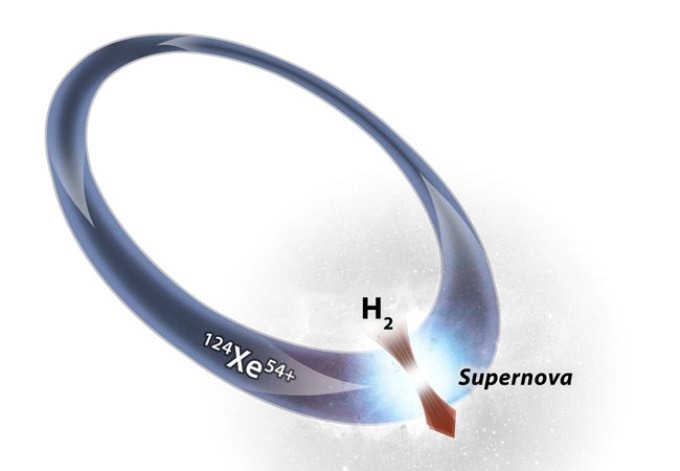Mar 19 2019
Heavy elements are created on the surfaces of neutron stars by the capture of hydrogen nuclei (protons) or during a stellar explosion. This takes place at very high temperatures, yet at comparatively lower energies.
 For the first time, the fusion of hydrogen and xenon was able to be investigated at the same temperatures as occur in stellar explosions using an ion storage ring. (Image credit: Mario Weigand, Goethe-Universität)
For the first time, the fusion of hydrogen and xenon was able to be investigated at the same temperatures as occur in stellar explosions using an ion storage ring. (Image credit: Mario Weigand, Goethe-Universität)
At present, an international team of researchers led by Goethe University has successfully probed the capture of protons at the storage ring of the GSI Helmholtzzentrum für Schwerionenforschung.
The researchers have described in the latest issue of Physical Review Letters that their aim was to more accurately determine the probability for a proton capture in astrophysical scenarios. Dr Jan Glorius from the GSI atomic physics research department stated that they faced two main challenges in their attempt.
The reactions are most probable under astrophysical circumstances in an energy range called the Gamow window. In this range, nuclei tend to be somewhat slow, making them difficult to obtain in the required intensity. In addition, the cross section—the probability of proton capture—decreases rapidly with energy. Until now, it has been almost impossible to create the right conditions in a laboratory for these kinds of reactions.
Dr Jan Glorius, GSI Atomic Physics Research Department.
About a decade ago, René Reifarth, Professor for experimental astrophysics at Goethe University, proposed a solution: It would be possible to reach the low energies inside the Gamow window range more precisely if the heavy reaction partner circulates in an accelerator where it interacts with a stationary proton gas. He was the one to achieve first successes in September 2015 together with a team of Helmholtz early career researchers. From that time, he and his colleagues have received outstanding support from Professor Yuri Litvinov, who heads the EU-funded research project ASTRUm at GSI.
As part of the experiment, the international team first created xenon ions. Their speeds were reduced in the experimental storage ring ESR and made to interact with protons. This led to reactions where the xenon nuclei captured a proton and transformed into heavier cesium—a process similar to the ones that take place in astrophysical scenarios.
The experiment makes a decisive contribution to advancing our understanding of nucleosynthesis in the cosmos. Thanks to the high-performance accelerator facility at GSI, we were able to improve the experimental technique for decelerating the heavy reaction partner. We now have more exact knowledge of the area in which the reaction rates occur, which until now had only been theoretically predicted. This allows us to more precisely model the production of elements in the universe.
René Reifarth, Professor for Experimental Astrophysics, Goethe University.
The experiment was performed as part of the research collaboration Stored Particles Atomic Physics Research Collaboration (SPARC), which is part of the FAIR research program. In this experiment, equipment funded by the Verbundforschung (collaborative research) of the Federal Ministry for Education and Research was used.